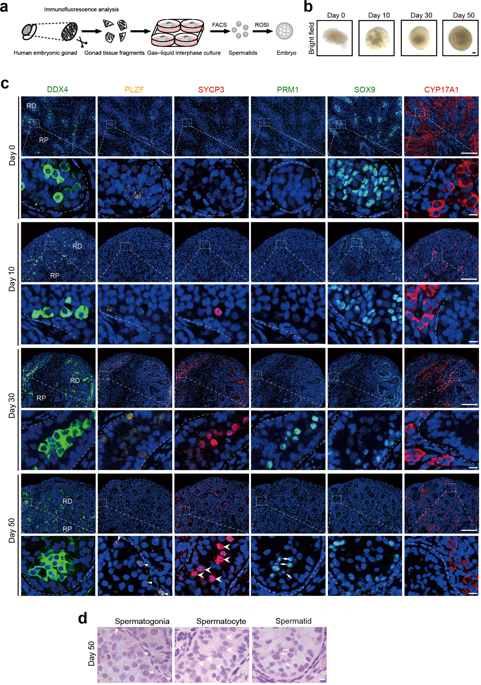Our official English website, www.x-mol.net, welcomes your feedback! (Note: you will need to create a separate account there.)
In vitro testicular organogenesis from human fetal gonads produces fertilization-competent spermatids.
Cell Research ( IF 44.1 ) Pub Date : 2020-02-21 , DOI: 10.1038/s41422-020-0283-z Yan Yuan 1, 2 , Laihua Li 2 , Qing Cheng 3 , Feiyang Diao 4 , Qiao Zeng 4 , Xiaoyu Yang 4 , Yibo Wu 1 , Hao Zhang 2 , Mingqian Huang 2 , Junqing Chen 2 , Quan Zhou 2 , Yunfei Zhu 2 , Rong Hua 2 , Jianyu Tian 2 , Xin Wang 2 , Zuomin Zhou 2 , Jie Hao 5 , Jinjin Yu 1 , Dong Hua 1 , Jiayin Liu 4 , Xuejiang Guo 2 , Qi Zhou 5 , Jiahao Sha 2, 3
Cell Research ( IF 44.1 ) Pub Date : 2020-02-21 , DOI: 10.1038/s41422-020-0283-z Yan Yuan 1, 2 , Laihua Li 2 , Qing Cheng 3 , Feiyang Diao 4 , Qiao Zeng 4 , Xiaoyu Yang 4 , Yibo Wu 1 , Hao Zhang 2 , Mingqian Huang 2 , Junqing Chen 2 , Quan Zhou 2 , Yunfei Zhu 2 , Rong Hua 2 , Jianyu Tian 2 , Xin Wang 2 , Zuomin Zhou 2 , Jie Hao 5 , Jinjin Yu 1 , Dong Hua 1 , Jiayin Liu 4 , Xuejiang Guo 2 , Qi Zhou 5 , Jiahao Sha 2, 3
Affiliation

|
Unlike most organs that mature during the fetal period, the male reproductive system reaches maturity only at puberty with the commencement of spermatogenesis. Robust modelling of human testicular organogenesis in vitro would facilitate research into mechanisms of and factors affecting human spermatogenic failure and male fertility preservation in prepubertal tumor patients. Here, we report successful recapitulation of human testicular organogenesis in vitro from fetal gonadal ridge. Our model displayed the formation of mature seminiferous epithelium and self-renewing spermatogonia. Remarkably, in vitro-derived haploid spermatids have undergone meiotic recombination, and showed increased genetic diversity as indicated by genetic analysis. Moreover, these spermatids were able to fertilize oocytes and support subsequent blastocyst formation. The in vitro testicular organogenesis system described here will play an important role in elucidating the regulation of human testis development and maintaining male fertility in prepubertal cancer patients.
中文翻译:

来自人胎儿性腺的体外睾丸器官发生产生能受精的精子。
与大多数在胎儿期成熟的器官不同,男性生殖系统仅在青春期随着精子发生的开始才达到成熟。体外人类睾丸器官发生的鲁棒建模将有助于研究影响青春期前肿瘤患者生精功能衰竭和男性生育能力保存的机制和因素。在这里,我们报告从胎儿的性腺脊体外人睾丸器官发生的成功概括。我们的模型显示出成熟的生精上皮细胞的形成和自我更新的精原细胞。值得注意的是,体外衍生的单倍体精子细胞进行了减数分裂重组,并显示出遗传多样性增加的遗传多样性。此外,这些精子能够使卵母细胞受精并支持随后的胚泡形成。
更新日期:2020-02-21
中文翻译:

来自人胎儿性腺的体外睾丸器官发生产生能受精的精子。
与大多数在胎儿期成熟的器官不同,男性生殖系统仅在青春期随着精子发生的开始才达到成熟。体外人类睾丸器官发生的鲁棒建模将有助于研究影响青春期前肿瘤患者生精功能衰竭和男性生育能力保存的机制和因素。在这里,我们报告从胎儿的性腺脊体外人睾丸器官发生的成功概括。我们的模型显示出成熟的生精上皮细胞的形成和自我更新的精原细胞。值得注意的是,体外衍生的单倍体精子细胞进行了减数分裂重组,并显示出遗传多样性增加的遗传多样性。此外,这些精子能够使卵母细胞受精并支持随后的胚泡形成。



























 京公网安备 11010802027423号
京公网安备 11010802027423号